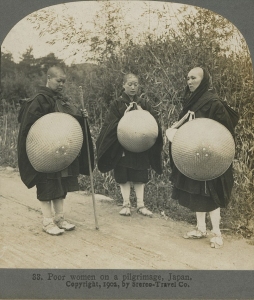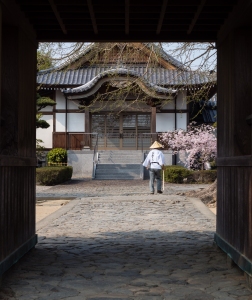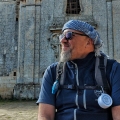Why walk over a thousand kilometers around a Japanese island, through temples, forests, and villages, with only a walking stick and a light pack? In an age of urgency and constant noise, the Shikoku Henro offers something radically different: a long pause, a deliberate rhythm, and a return to self through the body and the landscape.
One of Asia’s oldest pilgrimage routes, the Henro encircles the island of Shikoku, linking 88 Buddhist temples in a circular journey of approximately 1,200 kilometers. Each year, thousands of people follow its path. Some walk in faith, others in mourning, in search of renewal, or with no clear reason at all—only the sense that they need to walk.
A thousand-year journey
The Henro is traditionally associated with Kūkai (774–835 CE), also known as Kōbō Daishi, a Buddhist monk who founded the Shingon school of esoteric Buddhism. According to legend, he traveled the island in his youth, meditating in caves, mountains, and temples. Over time, his footsteps shaped the contours of this route.

For centuries, the pilgrimage was largely the domain of monks and ascetics. But during the Edo period (1603–1868), it became accessible to laypeople – farmers, merchants, the ill, the poor – transforming into a space of personal transformation outside daily routines.
The changing role of the Henro
In medieval times, itinerant monks known as hijiri traversed Shikoku preaching and meditating, often under harsh conditions. In the Edo era, with political stability under the Tokugawa shogunate, the route grew more structured: pilgrims carried travel permits, followed regulated paths, and some temples kept records of their passage.
Despite these controls, the pilgrimage retained its open spirit. For many on the margins of society – homeless, sick, or outcast – it became a form of refuge. Temples offered food, shelter, and dignity.
During the Meiji Restoration in the late 19th century, the state promoted Shinto and suppressed Buddhist institutions. The Henro declined, and many temples fell into disrepair. Yet popular devotion persisted. Throughout the 20th century, the route was gradually restored, evolving into a spiritual and cultural path that now attracts international interest.
Today, Japan recognizes the Shikoku Henro as part of its intangible cultural heritage. Though not yet a UNESCO World Heritage Site, the route is increasingly valued for its historical and experiential richness. Unlike more institutionalized pilgrimages, the Henro remains decentralized, unregulated, and flexible. There is no single authority, no official pass, no fixed direction. Each pilgrim shapes the journey on their own terms.
The route itself
Shikoku consists of four prefectures, and the pilgrimage route reflects a symbolic arc:
- Tokushima – Spiritual awakening
- Kōchi – Discipline and perseverance
- Ehime – Inner illumination
- Kagawa – Liberation or renewal
The 88 temples are traditionally visited in sequence, beginning at Ryōzen-ji near Tokushima and proceeding clockwise. Some walkers choose to go in reverse—a practice called gyaku-uchi—as a personal or spiritual challenge.
Completing the route on foot typically takes 40 to 60 days. Others divide the walk over multiple visits or use bicycles or buses. Still, walking remains the most meaningful and respected form of undertaking the Henro.
Who walks today?
Until recently, most pilgrims were Japanese—often older men, many retired. But this demographic is changing. In 2023, nearly half of those walking the route were foreign travelers, coming from Europe, the Americas, and Australia. Some were drawn by the natural beauty of Shikoku; others sought a spiritual journey outside of a religious framework. Several had walked the Camino de Santiago and came in search of a different kind of silence.
Motivations vary. Some walk after a loss, others to mark a life change, or to physically step away from a life that feels too full. Though never crowded, the trail is supported by local hospitality. The custom of osettai – gifting food, drink, or lodging to pilgrims – is still practiced. No payment is expected, only gratitude.
More than Temples: A way of life

Each temple along the route has its own landscape, architecture, and story. Some sit in cities, others in dense cedar forests or on mountaintops. Pilgrims can light incense, offer a prayer, and request a calligraphic stamp in a nōkyō-chō, the traditional stamp book.
Traditional attire includes a white robe, conical straw hat, and the kongōzue, a walking stick symbolizing Kūkai’s presence. The inscription dōgyō ninin—“two walking together”—reminds pilgrims they do not walk alone.
The rhythm of the Henro is quiet. The trail winds through mountain passes, rice fields, and humid valleys. The Kōchi section, known as the pilgrimage’s most challenging stretch, involves long distances between temples and sparse accommodations. Many quit here.
Those who complete the full circuit walk 1,200 kilometers over 6 to 8 weeks, averaging 20 to 30 kilometers per day, carrying little more than water, a journal, and the walking stick of the Daishi. Some continue to Mount Kōya, the site of Kūkai’s mausoleum—not as a final goal, but as a gesture of thanks.
Planning your henro
You don’t need to be Buddhist, or experienced. Just open to walking—and listening.
Essentials:
Distance: ~1,200 km
Time required (on foot): 6–8 weeks
Best seasons: Spring (April–May) and autumn (October–November)
Modes: On foot, by bike, public transport, or guided tour
Lodging: Local inns (minshuku), temples (shukubō), hotels, free shelters
Language: Japanese predominates, but English signage and guides are available
Bring: Comfortable shoes, sun protection, walking stick, light backpack, stamp book (nōkyō-chō)
The route is well marked, with maps, apps, and local associations to assist. But the most meaningful discoveries cannot be planned.
A journey that begins within
The Shikoku Henro is not a trend. It’s not only for believers. It’s a quiet path that invites change—without speeches or spectacle. Walk with what you have. Listen without judgment. Receive without expectation. Return, not with answers, but with a new way of seeing.
As one Japanese pilgrim said on reaching Temple 88:
“I didn’t find what I was looking for. I found something better—the ability to keep searching.”




